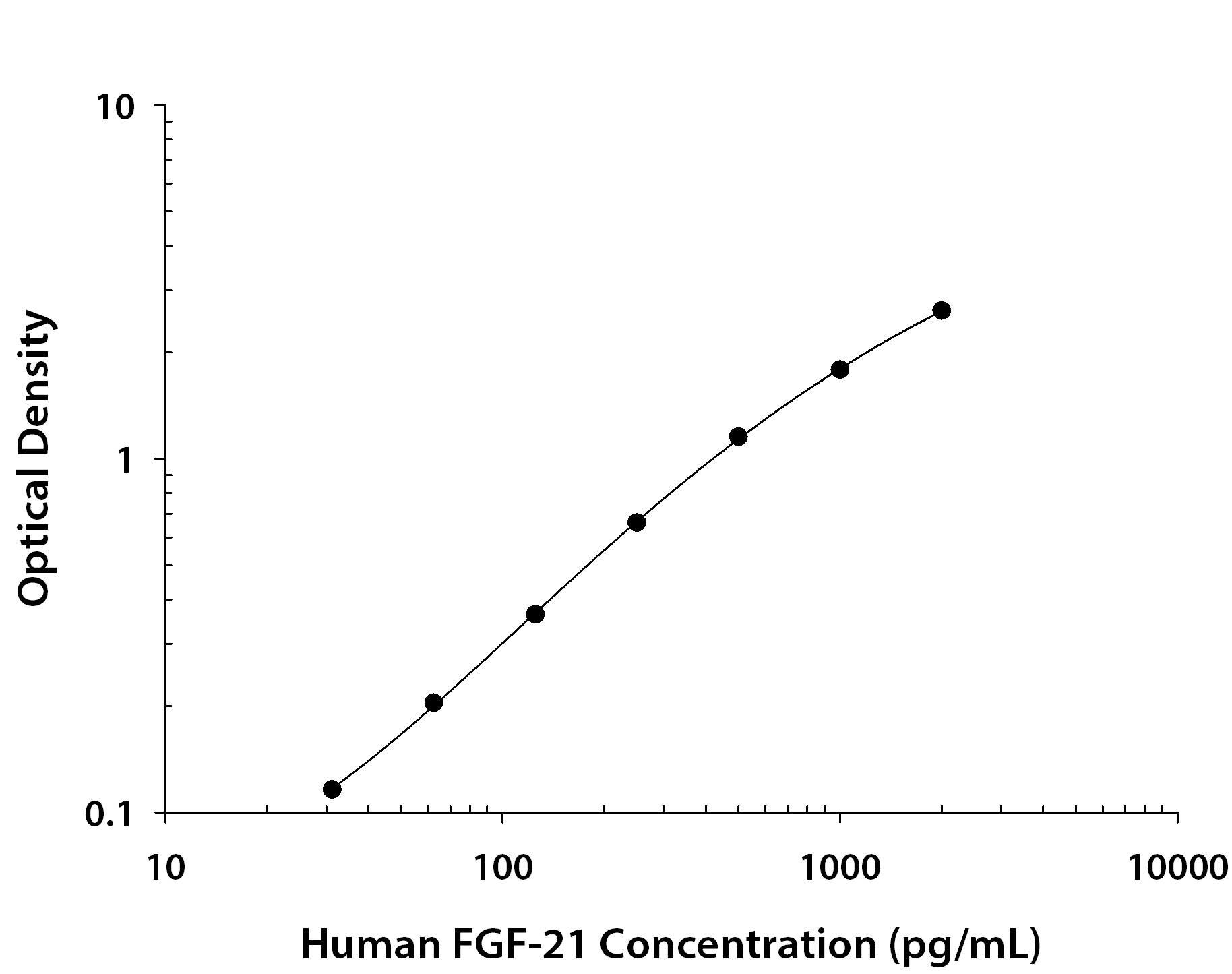Human FGF-21 Antibody
R&D Systems, part of Bio-Techne | Catalog # MAB25374

Key Product Details
Species Reactivity
Applications
Label
Antibody Source
Product Specifications
Immunogen
His29-Ser209
Accession # Q9NSA1
Specificity
Clonality
Host
Isotype
Scientific Data Images for Human FGF-21 Antibody
Human FGF-21 ELISA Standard Curve.
Recombinant Human FGF-21 protein was serially diluted 2-fold and captured by Mouse Anti-Human FGF-21 Monoclonal Antibody (Catalog # MAB25374) coated on a Clear Polystyrene Microplate (DY990). Goat Anti-Human FGF-21 Antigen Affinity-purified Polyclonal Antibody (AF2539) was biotinylated and incubated with the protein captured on the plate. Detection of the standard curve was achieved by incubating Streptavidin-HRP (DY998) followed by Substrate Solution (DY999) and stopping the enzymatic reaction with Stop Solution (DY994).Applications for Human FGF-21 Antibody
ELISA
This antibody functions as an ELISA capture antibody when paired with Goat Anti-Human FGF‑21 Antigen Affinity-purified Polyclonal Antibody (Catalog # AF2539).
This product is intended for assay development on various assay platforms requiring antibody pairs. We recommend the Human FGF-21 DuoSet ELISA Kit (Catalog # DY2539) for convenient development of a sandwich ELISA or the Human FGF-21 Quantikine ELISA Kit (Catalog # DF2100) for a complete optimized ELISA.
Formulation, Preparation, and Storage
Purification
Reconstitution
Formulation
Shipping
Stability & Storage
- 12 months from date of receipt, -20 to -70 °C as supplied.
- 1 month, 2 to 8 °C under sterile conditions after reconstitution.
- 6 months, -20 to -70 °C under sterile conditions after reconstitution.
Background: FGF-21
Fibroblast growth factor 21 (FGF-21) is a member of the FGF gene family, which currently contains 22 human members. Based on its structure, it is further classified as an FGF-19 subfamily member. This subfamily includes FGF-19, -21, and -23. Like all other FGF subfamilies, FGF-19 subfamily members contain a 120 amino acid (aa) core FGF domain that exhibits a beta-trefoil structure (1, 2). Unlike other FGF subfamilies, FGF-19 subfamily members apparently exhibit poor binding to ECM, resulting in highly diffusible molecules (3). The cDNA for FGF-21 predicts a 209 aa polypeptide that contains a 28 aa signal sequence and a 181 aa mature region (4). Notably, FGF-21, as well as FGF-19 show limited binding to heparin (4). One potential alternate splice form has been reported. It shows a 43 aa substitution for the C‑terminal 12 aa of the standard form (5). Mature human FGF-21 shows 81% aa identity to mouse FGF-21, and is known to be active on mouse cells (4, 6). The FGF‑19 subfamily is considered endocrine in nature. All three subfamily members impact some aspect of metabolism, all three are induced by a nuclear receptor heterodimer that includes RXR, and all three utilize Klotho family members for signal transduction (7, 8, 9). FGF-21 is produced by hepatocytes in response to free fatty acid (FFA) stimulation of a PPARa/RXR dimeric complex (3, 7, 10, 11). This situation occurs clinically during starvation, or following the ingestion of a high-fat/low-carbohydrate diet. Upon FGF-21 secretion, white adipose tissue is induced to release FFAs from triglyceride stores. Once FFAs reach hepatocytes, they are oxidized and reduced to acetyl-CoA. The acetyl-CoA is recombined into 4-carbon ketone bodies (acetoacetate and beta-hydroxybutyrate), released, and transported to peripheral tissues for TCA processing and energy generation (11, 12).
References
- Itoh, N. and D.M. Ornitz (2004) Trends Genet. 20:563.
- Mohammadi, M. et al. (2005) Cytokine Growth Factor Rev. 16:107.
- Huang, X. et al. (2006) Mol. Carcinog. 45:934.
- Nishimura, T. et al. (2000) Biochim. Biophys. Acta 1492:203.
- GenBank Accession #: EAW52401 (2006).
- Ford, A.M. et al. (2005) J. Clin. Invest. 115:1627.
- Moore, D. D. (2007) Science 316:1436.
- Ogawa, Y. et al. (2007) Proc. Natl. Acad. Sci. USA 104:7432.
- Kurosu, H. et. al. (2007) J. Biol. Chem. 282:26687.
- Lundasen, T. et al. (2007) Biochem. Biophys. Res. Commun. 360:437.
- Badman, M.K. et al. (2007) Cell Metab. 5:426.
- Inagaki, T. et al. (2007) Cell Metab. 5:415.
Long Name
Alternate Names
Gene Symbol
UniProt
Additional FGF-21 Products
Product Documents for Human FGF-21 Antibody
Product Specific Notices for Human FGF-21 Antibody
For research use only
